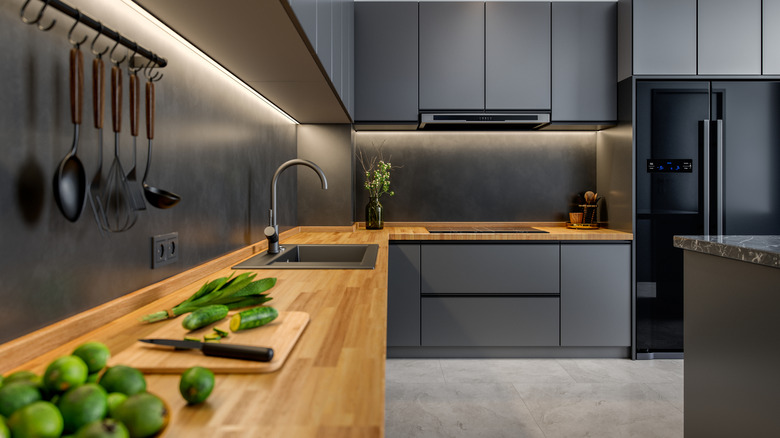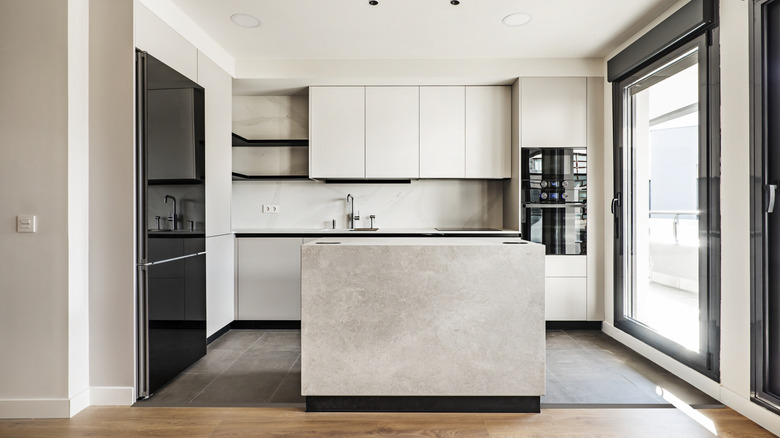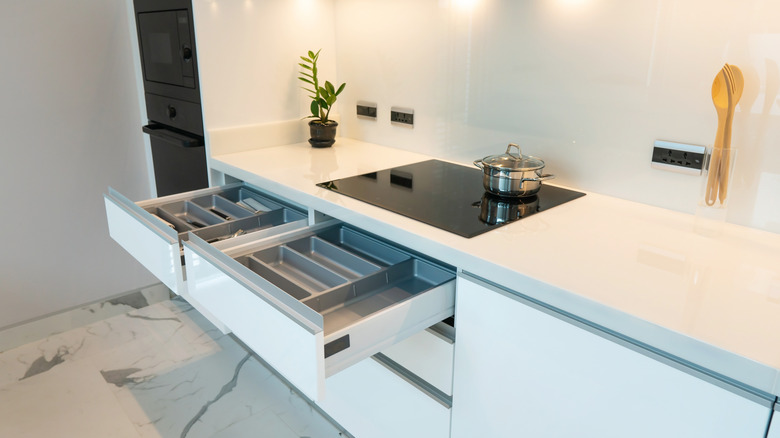The Sleek Kitchen Cabinet Design Trend To Try For The Perfect Minimalist Look
Renovating a kitchen usually entails a never-ending list of design decisions. There are lots of styles you can go for, from a traditional farmhouse-inspired kitchen to an ultra-modern, dark, and moody kitchen scheme. If you want to embrace minimalism in the kitchen, an easy and effective way to do so is to opt for handleless cabinets. Handles — or the lack thereof — may seem like a tiny detail that won't make much of a difference to the overall look of your kitchen. However, this small detail makes a big impact: flat, smooth cabinet surfaces exude minimalism and create a clean, simple aesthetic.
Handleless kitchen cabinets are pretty self-explanatory. They are a flat cabinet style that doesn't require a handle to open or close. Those with an inclination for minimalist design tend to choose this style of cabinet because it offers a clean, smooth, and sleek finish. However, before deciding on this design, consider its cost implications, the ease of cleaning, and whether you'll still love the minimalist look years after you install them.
How handleless kitchen cabinets work
First, it's important to understand the different types of handleless kitchen cabinets. There are three main designs: J-pull, true handleless, and push-to-open handleless cabinets. So, how do they differ? J-pull doors have a handle that is integrated into the cabinet door itself and presents a 'J' shaped curve along the edge. This allows you to easily grip the door and open it efficiently. True handleless cabinet doors, as the name suggests, appear completely handleless. They have no visible handles; instead, a rail behind each door creates a small gap for your fingers to grip. Lastly, push-to-open doors rely on you gently pushing in the door or drawer, which activates a latch and allows it to fully open — arguably the most user-friendly.
In terms of cost, J-pull handleless doors are generally more affordable than true handleless or push-to-open styles. This is because J-pull doesn't feature a complex mechanism that would naturally drive up the overall cost of the doors and installation. Despite their simplicity, J-pull doors still offer a sleek, minimalist look without the hefty price tag. However, if your budget allows, a true handleless or push-to-open design might be the better choice for your aesthetic.
These are the pros and cons of handleless kitchens
The main reason some people opt for a handleless kitchen is that they like the clean and modern aesthetic that it affords. Cabinet handles can make a kitchen scheme appear busy and immediately draw one's eye — even if they're small and elegant. With handleless cabinet doors, the opposite is true. When you look into your kitchen, you see an uncluttered, clear space. This quality also means that handleless kitchens are a fantastic choice for smaller kitchens. Another advantage of this design is improved safety, especially if you have small children at home. Handleless kitchens reduce the risk of bumping into protruding handles or catching clothes on them. Likewise, handleless drawers and cabinets are safer because any little ones you have running around won't be able to easily grab the handle and open them without permission.
There are a few negative aspects to note as well. As they don't have a handle to grab on to, handleless cupboards are often left with finger marks on them and therefore require more regular cleaning, especially if your doors have a glossy finish. Apart from making your space look dirtier, handleless kitchen cabinetry can be expensive; typically, it costs anywhere from 15% to 50% more than traditional cabinetry with handles. So, you'll want to do your research beforehand to see if this type of design fits into your budget.


